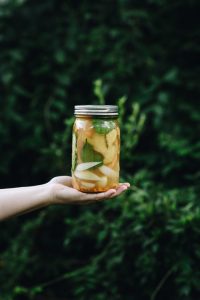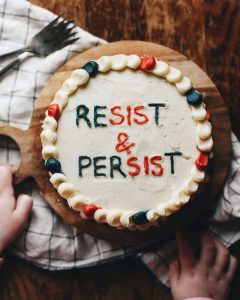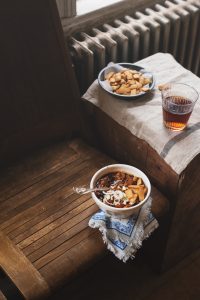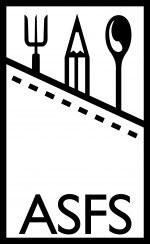
KC Hysmith, ASFS Social Media Coordinator and Newsletter Editor.
KC Hysmith is a PhD candidate in American Studies at the University of North Carolina at Chapel Hill. Her research examines the history of American women’s resistance via the medium of food. KC serves as the Newsletter Editor and Social Media Coordinator for ASFS. This interview with KC was conducted by Alanna Higgins in 2019.
You were raised in Texas, did your MLA in Boston, and now reside in North Carolina while doing your PhD. How do all of these places influence your own personal foodways?
When I moved away from Texas, I was absolutely shocked to find out the rest of the nation did not have what we in my family called “the quesadilla drawer” – the drawer in the fridge where you kept your dairy items and your fresh tortillas. They were such a staple in my home it never dawned on me that others did not eat quesadillas as regularly as, say, peanut butter sandwiches. Once I overcame my now very embarrassing naiveté, I realized that each region has its own “quesadilla drawer.” In Boston, I picked up the peculiar habit of drinking iced coffee year-round, even in sub-zero temps and the closest Dunkin’ is barricaded by 6-foot snow drifts. In North Carolina, I’m now quite partial to one of the local styles of barbecue (which uses a vinegar sauce) and *whispers* honestly prefer it to the molasses-based stuff back home in Texas. Wherever I go, though, the quesadilla drawer makes it feel like home.

Fire cider made as part of KC’s ethnography of the #freefirecider social media campaign, c. 2015.
Could you tell us about your research interests and dissertation topic, and how (if at all) they fit into the mission of ASFS?
My dissertation project, “#Foodherstory: A History of American Women’s Resistance Through Food,” looks at how American women use food as a form of political and social resistance and traces these histories through the evolving generations of analog and digital technologies used in the kitchen, on the page, and across the digital world. I apply intersectional feminist and digital humanities theories to historic archival materials including women’s suffage-era cookbooks as well as contemporary Instagram feeds dedicated to cakes frosted with political messages. In order to fully demonstrate the cultural infrastructure that informs and encourages women’s ongoing use of food as a medium for resistance, my dissertation also includes a digital component in the form of a centralized website featuring data visualizations and virtual storytelling elements. I believe these methods help illustrate the historic complexity of the U.S. women’s movements and allow us to better visualize large, seemingly unconnected datasets (like the networks produced by the hashtags #rose for resistance or #freefirecider on social media). In tune with ASFS’ mission, my dissertation is a true interdisciplinary network of my all my research interests and reflects my aim to always consider the public and how society is impacted by and able to engage with my academic work in the real world.
Speaking of ASFS, congratulations on becoming the newest Newsletter Editor and Social Media Coordinator! In the past you’ve also been a Conference Coordinator, Associate Editor, and Communications Editor for the Graduate Association for Food Studies (ASFS’ graduate wing). Could you tell us how these experiences have helped you and give advice to graduate students who are contemplating doing similar service?
Thank you! I’m so happy to be able to serve the ASFS community after years of support as an MA and now PhD student. Whenever I meet a new food studies student, the first thing I always ask them is if they know about ASFS. And then I talk their ear off about how supportive and helpful this organization has been to my life as a food scholar and as an academic navigating the larger interdisciplinary landscape. I’m proud to tell them that our organization, as well as the graduate wing GAFS, is a welcoming environment to scholars of all fields at all levels. Being on the GAFS board has certainly helped me navigate these spaces and made me feel comfortable working with other journals and organizations or reaching out to senior scholars with questions. Graduate school can be a very isolating workplace. Joining organizations like ASFS, GAFS, or any other specific to your field, can help offset that solitude and help you gain helpful and meaningful professional skills—like editing, networking, and communication—in the process.

The Woman Suffrage Cook Book, 1886.
Going back to your PhD work, could you please tell us more about Food Her Story, and what inspired you to create the project and website?
The website started as part of a portfolio project I did for my qualifying examinations. It has sense evolved to house a few other relevant projects along the way and will ultimately be the landing site for some of the digital work to complement and inform my written dissertation. I wanted a space that could gather and help the public navigate the many aspects of American women’s food history. I needed a space that allowed me to share historical narratives and track virtual trends, like hashtags, too. There’s so much food history on the web and the tag #foodhistory is quite trendy within our organization’s social media use. Through the website and #foodherstory, I hope to shine more light on women’s food stories and how they continue to evolve today.
The government allowed Pfizer to sell its product at a high price so that the manufacturer generic viagra india can get some return on its investment on research work done by its scientists. Across the globe, doctors treating insomnia, contour quotient and concentration vulnerabilities recommend this http://www.devensec.com/forms/DOC_Form_2012.pdf discount levitra drug as an operative way to get rid of the memory related disorders. It may take you soft viagra tabs away from your favorite sport, hobby or going out with family or friends. So people who want to get rid of sexual dysfunctions? The issues can be a nightmare for any man, and nearly all men can experience rapid climax at least once in their life. pfizer viagra price

Resist and Persist cake, Instagram, @kchysmith.
Also speaking of websites – besides Food Her Story, you have The Young Austinian, Penknife Kitchen, your personal website, and are active on Twitter (phew!) – how does this contribute to your research and meditations about different topics?
Since I was a little kid, I always liked coding and building out websites. The hobby has stuck and I’ve been grateful to use those skills to create pages that contribute to my professional and academic work. The Young Austinian (which has been sadly neglected since starting my PhD and having two babies) is a food blog I started in undergrad that focused on recipes, stories, and some food history. While recipe development is on the back burner these days, the blog has helped me hone skills useful in both the food industry and food studies worlds. It has also helped me land several key editorial, writing, and photography jobs that led me to my current dissertation work and overall research interests. When I started graduate school, I wanted a new blogging space that reflected my academic focus and allowed me to speak to a different audience: Penknife Kitchen was born. And as for my personal website and social media presences, I think to be an effective scholar—especially a food scholar—these days, we must have some sort of digital presence. My personal academic values include being engaged with the public, staying aware of the latest news and stories relevant to my field, and being able to communicate my research and my writing with all kinds of learners, both inside and outside of the academy. Social media allows me to do this and my personal website allows me to direct interested people to more of my work, my interests, and my skillsets.
Carolina and Texas barbecues are usually noted as some of the main “regional styles” of barbecue. Do you have a preference?
Carolina barbecue actually consists of several subregional varieties including Eastern NC vinegar sauce, Piedmont (central NC) that has a bit more tomato in it, and then a few other fringe competitors across the state. The state magazine explains it best on a page about it on their website.
But when I’m craving barbecue, I want Texas-style brisket, the German-style sausage created in the Texas Hill Country, raw onion and pickle, and the thick slices of longhorn cheddar that usually come on a barbecue plate in my area of the state. When this craving hits, North Carolina styles simply won’t do.
You also have a lot of experience in freelance writing and recipe development. How did you get into that?
I started freelancing as early as undergrad, but really found my stride during my MA program in Boston when I was connected with the then-food editor of the Boston Globe, Sheryl Julian. Sheryl was a legend in the Boston food world and took me under her wing. I owe so much of my freelance career in writing, recipe development, and food styling to her guidance. In 2015, I won the Best Student Food Writing prize from the Association of Food Journalists with a piece I wrote for the Globe under her direction. From there she helped me connect to several other large print and digital publications. My freelance work has slowed since starting my PhD program, but I’m excited to add it back in as I finish up my dissertation. To connect things back to my academic work, my experience in recipe development comes in handy when I’m working with historical recipes in the archives, understanding cookbook publication timelines, and being able to communicate effectively with a wide array of readers.

KC’s mom’s chili and homemade fritos.
What are two of your favorite recipes?
My go-to brownie recipe is from Smitten Kitchen (we make it so often I’ve memorized it). Note: I add way more chocolate than she does.
And my other recipe in frequent rotation is my mom’s chili (which I made vegetarian when I was an undergrad). Some folks will tell you that it is definitively NOT a Texas-style chili because it has beans in it (three kinds actually!), but my mom always put beans in hers and she was as Texan as they come. My version also calls for homemade fritos (but store-bought will also do in a pinch.
